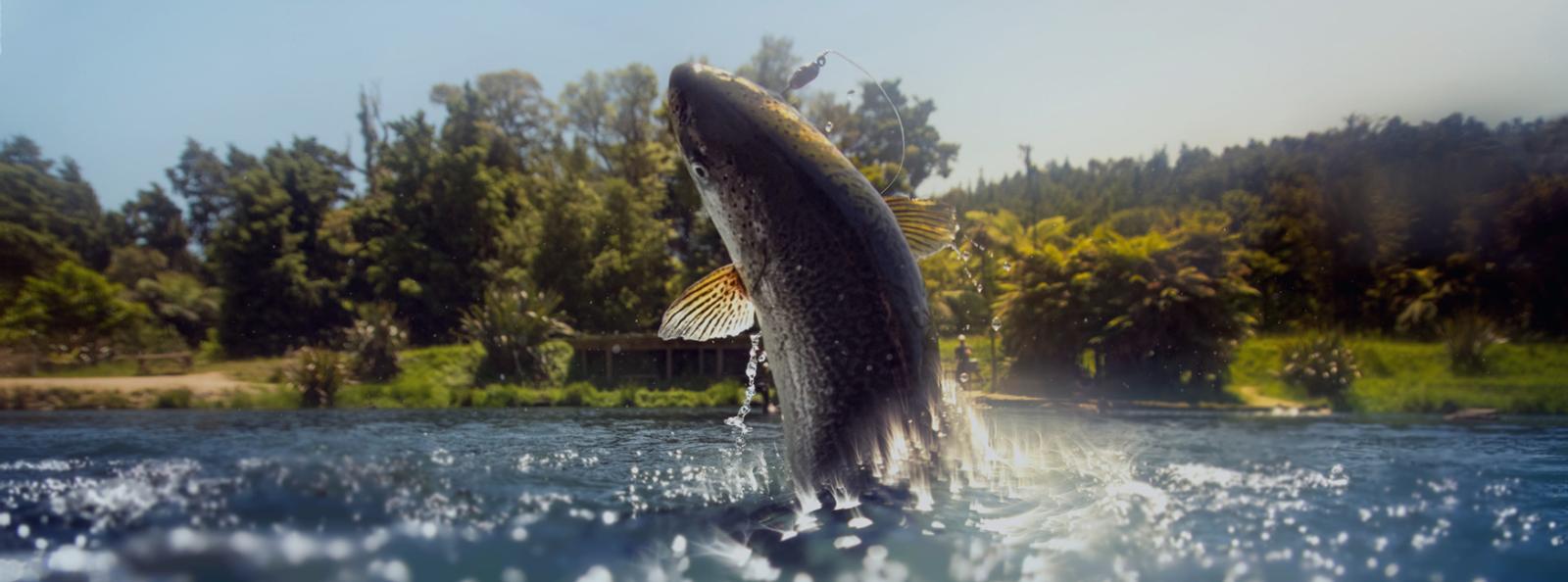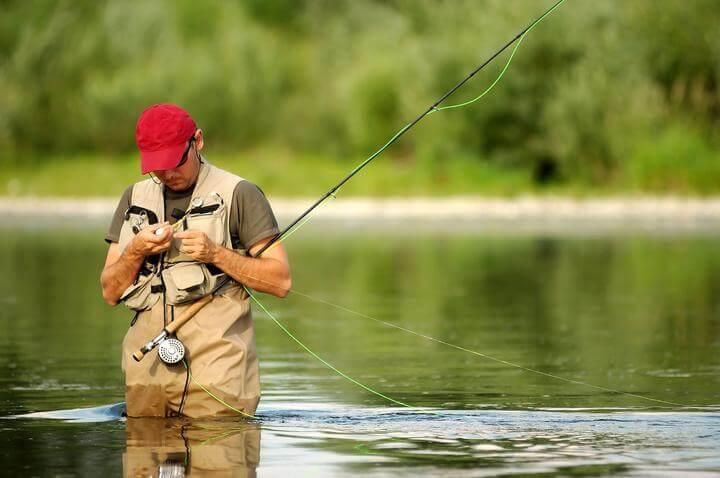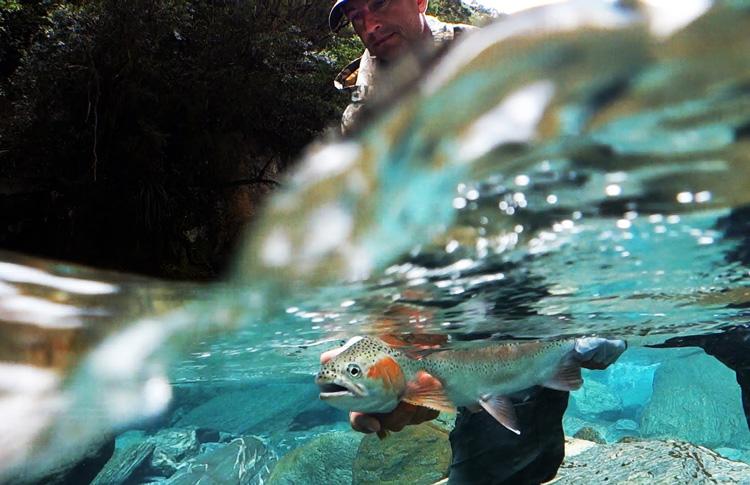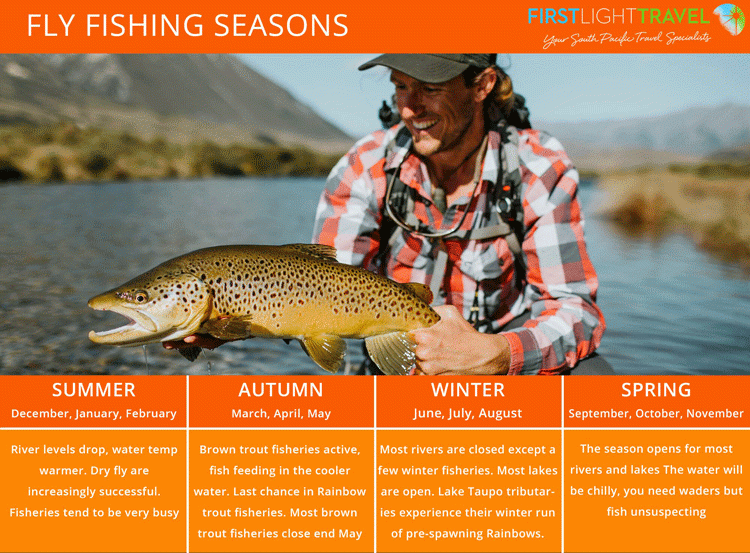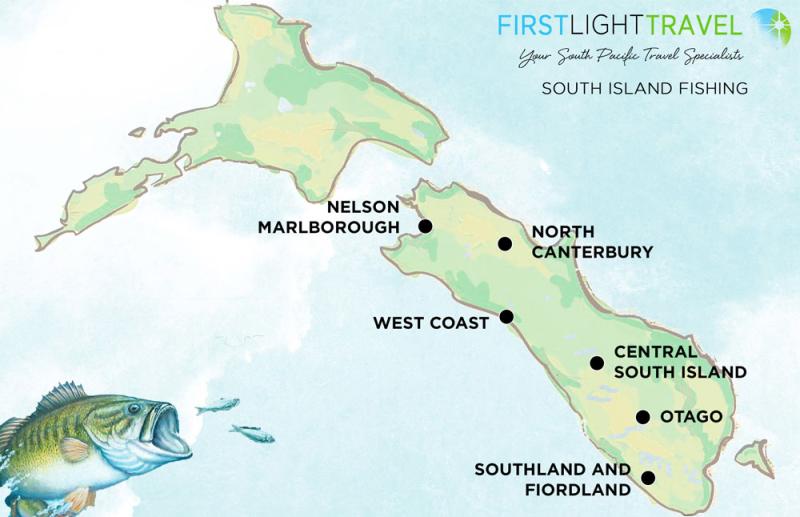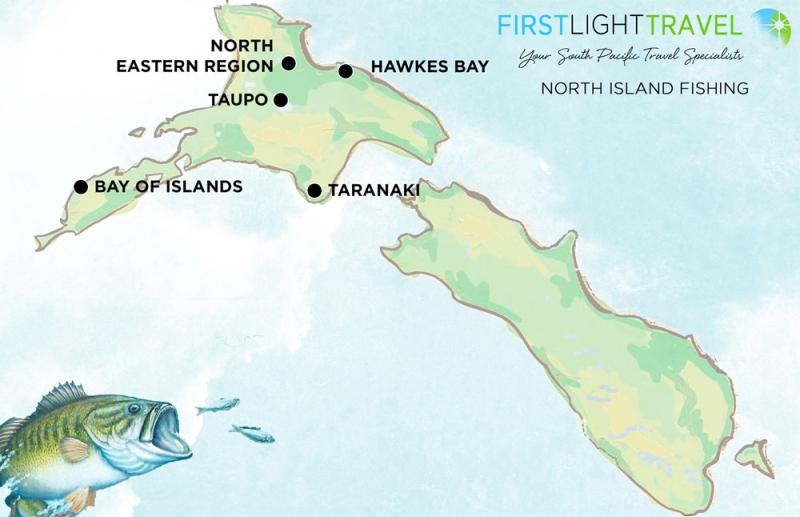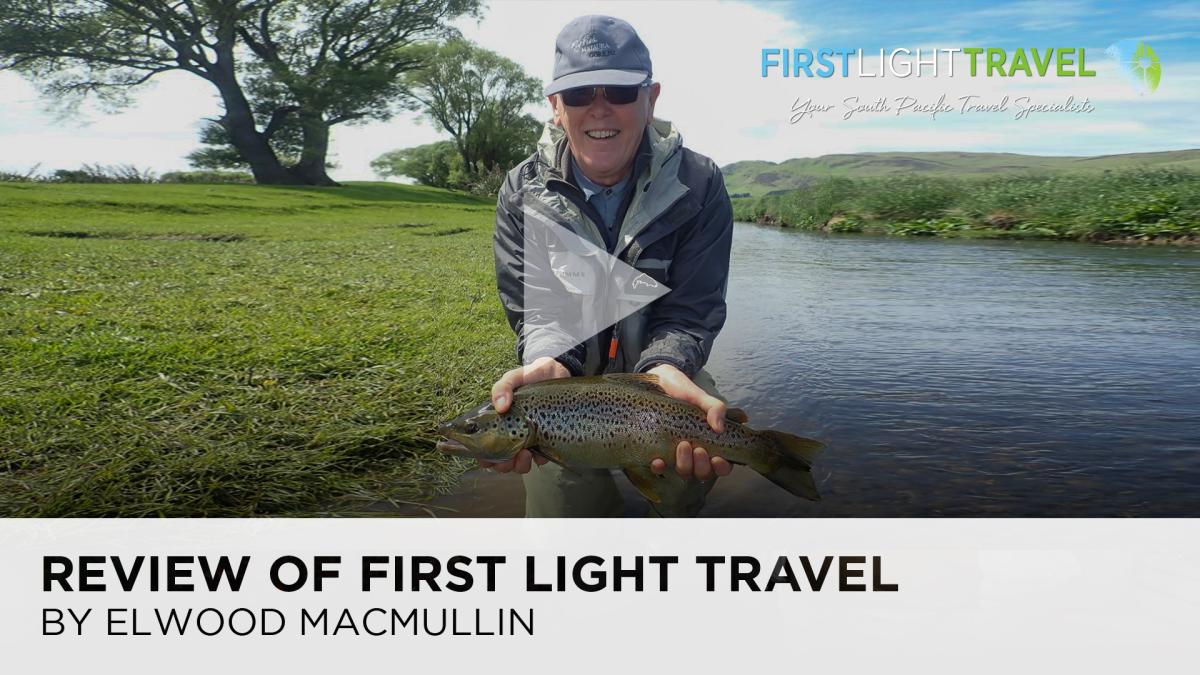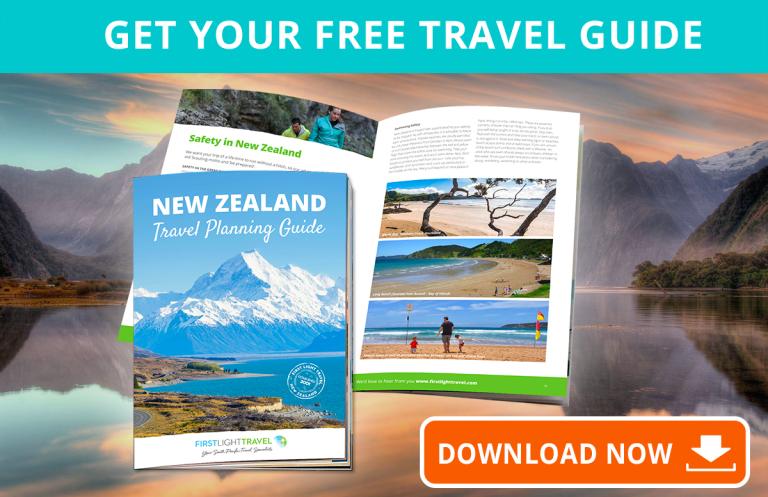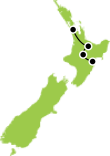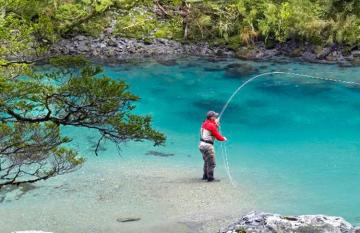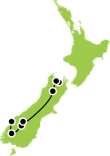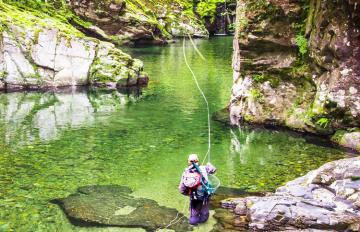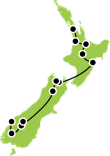
New Zealand has a great reputation for recreational fishing. We have world famous inland river, lake fisheries, and coastal saltwater fishing. All types of fishing are practiced here but it’s fly fishing in New Zealand that gets people popping down to paradise.
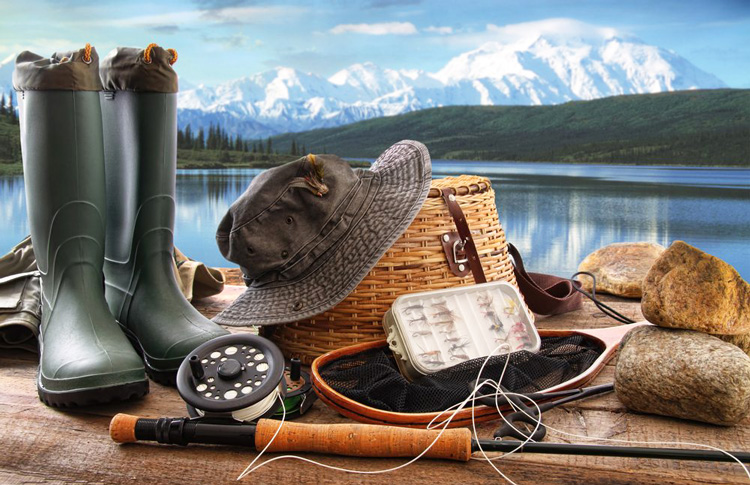
Contents
I get a good all-round buzz from fishing. Being a Cantabrian, I am spoilt for choice in our South Island waterways. I’d take a few hours of any fishing method, including spinning, trolling, jigging or surf casting, but my favorite is fly fishing with a light line. I don’t hunt trophy fish, figuring that the big ones can do without the shock. I catch and release unless I need a feed.
Honestly, I don’t know what appeals more about fishing here. It may be the stunning scenery and solitude, the journey and adventure, the anticipation and thrill. Perhaps this will whet your appetite with a little local knowledge.
New Zealand has two main trout species.
Brown trout were introduced from Europe in the 1860s. They have spread throughout New Zealand's rivers and lakes offering self-sustaining, plentiful, wild trout fisheries. Areas with a low population are supplemented by releases of trout by New Zealand’s recreational fishery management agency Fish and Game. Trout can grow to trophy sizes of 4.5kg but they get wary and wily at that size. Brown trout can be escape artists, ducking for cover under banks and fallen branches – anything to snag your line and get free. It pays to draw them away from snags if you can. Resident trout populations live in the rivers middle and upper reaches and lower reaches have runs of sea-run brown trout in the lower reaches over spring and summer.
Rainbow trout were introduced from Californian steelhead stock in the 1880s. They are not as widespread as the brown, but have developed into localised fisheries in central North Island and in the backcountry of the South Island. Rainbows tend to be bold feeders, put up a good fight, have a habit of launching into the air when hooked and so, are well worth the effort.
Salmon is generally limited to the South Island which has suitable geography and temperature for well-established populations of sea-run salmon. Between December and May, wild salmon will leave the salt water, enter the fresh water, and swim up the river to spawn. River mouths like Rakaia, Waimakariri, Waitaki, and Huranui are suitable for surf and river fishing methods. The Kaikoura and Otago coastlines are excellent sea-run salmon fisheries and support those methods as well as trolling from a slow-moving boat. The idea is to be in the right place, at the right time, when river levels and surf conditions combine in the right mix.
Land-locked Salmon, including Chinook or Sockeye, are supported and maintained in some South lsland lake fisheries like Lakes Coleridge, Heron, Sumner, Wakatipu, Wanaka, and Hawea. Spin or lure fishing, and trolling from a boat with a diving lure are the methods of choice in these lakes. Land-locked salmon are feisty on the end of your line but, as they tend to travel in shoals, persistence is generally the key to success to find a shoal. Nothing beats taking the boat to Lake Coleridge for an afternoon trolling for some Sockeyes. Coleridge’s South East to North West position between the mountains makes the lake a bit of a wind tunnel so often the boat is propelled by the wind rather than the motor and conditions can cut up a bit rough at time. I appreciate the place for its scenery and remoteness, and salmon is beautiful barbequed with a little lemon (and a cold beer).
Interested in Fly Fishing in the North? Take a look at our North Island of New Zealand Fly Fishing Itinerary
Our Conditions
Our fisheries are unpressured. On one hand, our fish are not predated by non-humans. On the other, only 80,000 New Zealanders are recreational anglers (out of just under five million people). It’s fairly usual to walk a river bank all day without seeing another person. New Zealand has literally hundreds of waterways available to choose from and the cost of a license is a small price to pay for such a privilege.
In New Zealand, we are exposed to a predominant westerly airstream which provides a temperate climate and consistent rains which allow our rivers and streams to be an optimal temperature range and river level for trout to thrive. That’s the good side. In my experience, it is often blowing a Nor’west gale on my scheduled fishing days. If the wind is forecast it’s well worth getting up early in an attempt to avoid it. From a philosophical point-of-view fishing in a wind gives me a strong right arm and a certain talent with a heavy weight-forward line.
Our weather can change quickly and without much warning, especially in the backcountry, where you might have strayed a long way from your vehicle. Fishing activity can be triggered by heavy rain or a drop in barometric pressure, so it usually pays to carry on fishing. Just make sure you are prepared for any eventualities.
There is no doubt that fish activity has its peaks and troughs in a day, but in mid-summer trout seem to get a little lazy. They tend to hold just out of the current and snack if anything tasty that goes past its nose. Our goal is to slide a tasty looking morsel past their nose. In my experience, enjoy the journey, eat your own lunch, and walk upstream and fish the next qualifying spot.
I have a lovely 6-weight Sage rod that I use mostly or Canterbury rivers and lakes. It’s a snappy, quick loading rod that delivers the fly line nicely, especially under trees. I have an 8-weight set too for bigger water. I tend to use 1.8 kg breaking stain for smaller streams and have another reel loaded with 4kg for larger rivers estuaries and lakes. I stick with dull coloured lines and keep about 50 meters of backing on my reels.
Interested in Fly Fishing in the South? Take a look at our South Island of NZ Fly Fishing Itinerary
Reading the water
The best place to fish is anywhere there is an abundant food supply, cover or deep water for shelter and well-oxygenated water. In rivers, trout tend to sit nose upstream, in the slack water off to the side of the main current where a rapid spills into a deep pool so that’s the place to look for. Fish in pools with a featureless bottom and slack water only if you sight a fish, as these places generally are unproductive. It pays to move upstream between these pools to maximise your effort.
In a lake, the best place is often by an inflow of a river or stream, near a weed bed or boulder. Fly-fish with a long line over a drop-off and retrieve the fly slowly, working it from past the drop-off and across the weed bed.
Our larger rivers and lakes, and braided rivers are well suited to spin fishing and there are often deep pools and swirling water that is difficult to fish with a fly. Braided rivers, in particular, are often discoloured from sediment transport, but they fish well regardless. I generally swap to a spin set, get in the right spot and work the discoloured areas.
Many of our larger rivers and lake-edges are overhung by willows, so wading to get to the best spot can be impossible. Consider drift fishing as it allows you to cast under the willows into the shallower water. A kayak or rowboat can really add another dimension, and on a hot day, it is so much more fun.
Sight-fishing
The great thing about many of our waterways is their clarity and sight fishing is the most exciting way to fish. Insight fishing, you can sight your trout and watch its behaviour, and how it lies in the water. Then you set about planning your approach, choosing your fly, and selecting a landing site all before you cast to target that fish. The clear water allows you to watch the trout’s reaction - will it be attracted and move to the fly, or has it already had enough dinner and move away. Then you adjust your plan. Minutes unfold into hours, and who is in a hurry anyway, as long as you can see your quarry.
I was out spotting at the Hurunui River (North Canterbury) and found a place where the deep water ran between cliffs. I saw five average and one large brown trout sitting in the flow. Not feeding, just sitting from what I could see. No shallows or beach, very deep fast flowing water, and just one very small flat about 25 meters away. I couldn’t let the moment pass and the situation couldn’t have been more challenging. After a careful climb down my quarry was still sitting in the flow. It was great fun, and I did my best, but when I climbed out of the gorge much later that large brown trout was still sitting in the flow, smiling, I thought. They don’t get that big without a certain amount of cunning.
Check out all the top New Zealand fly fishing spot with The New Zealand Fly Fishing Extravaganza
Our fishing season
The freshwater fishing season in most areas runs from October to May and each region has its own set of regulations which should be researched. It also pays to be aware of the changes in conditions and fish behaviour as the year progresses.
October: The season opens for most rivers and lakes, except some high country Rainbow trout streams. The snowpack melt tends to be long and gradual, and rivers are only disrupted by heavy rains. Water in tributaries is generally clearer and the confluence of riverways is a good bet for fishing. Dry Fly and Nymph fishing for browns are recommended for most rivers. The water will be chilly, so you need waders but the fish, having not been targeted for three months will be more unsuspecting. The water temperature in lakes, though cold, will be consistent and fish will be evenly distributed.
November: Rainbow Trout fisheries open. The weather is warming and the fish are feeding, accumulating bulk and muscle after winter. The dry fly hatches and nymph fishing continues in rivers. It’s the best month for a trophy trout as there are still few anglers and the trout are freely consuming food. In lakes its best to use fishing methods that reach the bottom.
December: River levels drop and water temperatures are warmer. Dry fly are increasingly successful and nymph fishing should still be successful.
January: High summer in New Zealand. The rivers are mostly low and clear, and the bigger rivers fish extremely well. Time for terrestrial and dry fly fishing.
February: Dry and terrestrial flies are at their peak. River levels are lower. Fisheries tend to be very busy in February, but every trout in every river is rising.
March: A change of seasons as the first frosts arrive around mid-month. The terrestrials disappear then but are replaced by afternoon mayfly hatches. There are fewer anglers about so the fish are less pressured. Fly-fishing Mataura River in Southland is just great.
April: Brown trout fisheries are active with the fish feeding in the cooler water on consistent mayfly hatches. Brown Trout start staging for pre-spawning runs and they move out the lakes and up into the tributaries. It’s a perfect month for dry fly buffs.
May: Last chance in Rainbow trout fisheries. Most brown trout fisheries close.
June to September: Most rivers are closed except a few winter fisheries. Most lakes are open and the Lake Taupo tributaries experience their winter run of pre-spawning Rainbows. Many estuarine areas of rivers in both Islands remain open and provide great sport for sea-run brown trout especially in the smelt and whitebait season in August.
Here is my Fly-fishing bucket list
Retirement may be a few years away for me but I am actively investigating and planning a few fishing trips. These are my drawcards. Perhaps they will whet your appetite. Maybe I’ll see you on the water.
South Island
Nelson Marlborough: I’ve had some wonderful sea fishing adventures including jigging for blue cod and around the Outer Sounds and D'urville Island, floundering and snapper fishing in the inner sounds, and scallop dredging in Golden Bay. I’m keen to try with a fly in the boiling Buller River and experiencing the variety of conditions offered in the Clarence and Motueka Rivers. Beautiful rivers flow through pristine native bush, and some lakes have bush right down to the water’s edge.
West Coast: There are lots of rivers running from the Southern Alps to the Tasman Sea that are the playground to sea-run trout and salmon. The rivers are mostly accessible by vehicle and are lightly fished. While the scenery is excellent, the rivers can be moody due to the high rainfall so it’s best to prepare for all eventualities.
Southland and Fiordland: Fiordland is one of the grandest, most rugged spots in New Zealand. There will be blue cod fishing in the deep, cold sea waters for sure, but the trout waters (Eglinton, Cleddau and Hollyford Rivers) are bountiful and the fish are comparably untroubled by anglers. A good opportunity to try drift and spin fishing and harling, as well as fly.
Southland’s deep, glacial lakes, Wanaka, Wakatipu, Te Anau, and Manapouri, offer challenging salmon and trout fishing. It also has smaller, less accessible lakes like Mavora. Mataura River and its tributaries offer over 150km of easily accessed waters with brown trout and the occasional salmon. It’s a top dry fly river system.
Otago: Mataura, Clutha, and Taieri are rivers of my youth and I’m keen to get back for some more. Brown trout, rainbow trout, sea trout, chinook salmon and perch are at home here. These rivers offer a wide diversity of terrain and waters that make it suitable for all methods and skill levels.
Central South Island: I’ve fished the hydroelectric lakes, Ohau, Pukaki, Benmore and the remote Colleridge by trolling, but with more time on my hands, I’m keen to work the waters by the fly. I’ve spotted big trout in the clear snow-fed water of the Ahuriri River, and there is brown and rainbow trout, and chinook salmon in the mighty Hakataramea River. Some very big rivers (Rangitata is meandering, Waitaki is braided) flow into the Pacific Ocean and have good populations of Quinnat salmon, brown and rainbow trout. Smaller rivers like the Ashburton, Opihi and Waihao River offer blind fishing for sea-run brown trout in the lower reaches and sight fishing in the upper reaches.
North Canterbury: The larger braided and meandering rivers, and the smaller rivers and streams all offer excellent fly fishing. Rakaia and Waimakariri are known as excellent salmon rivers, and Hurunui and Ohau offer a variety of conditions with wily browns at the headwaters, and sea-run trout and feisty salmon in the lower reaches.
North Island
Bay of Islands: Great opportunities for saltwater fly-fishing in Bay of Islands. It’ll be an excellent reason to invest in some heavier gear - a 12 weight rod and all-aluminium reel, should do the job. The Bay of Islands also has marlin, kingfish, kahawai, and terakihi, so I am banking on a month or two in my retirement plan. Maybe I’ll hire a launch and head for the river mouths, reefs and bays, and target shoals in deeper waters. I hear there are some excellent charters available…
Taupo Region: Tongariro River is the place to get to grips with raft fly fishing and experience some untouched pristine water, and it’s a spawning river for Lake Taupo. Lake Taupo is a large, cold lake is home to a huge population of both brown and rainbow trout and if I am to get a trophy fish I suspect it will be here. Heli-fishing makes the less accessible reaches available. I’d like to fish the great Wanganui, River, and the Mohaka, Rangitkei and Ripia Rivers. All are rainbow and brown trout territory.
Taranaki Region: Central west coast of North Island appeals for its volcanic landscapes and sub-tropical rainforest but also its unpressured fishery. Mount Taranaki is the source of over forty small to medium sized rivers and streams with stocks of rainbow and brown trout.
North Eastern Region: I hear Te Urewera National Park and Lake Waikaremoana have spectacular wilderness fishing. After that, there are the 13 fishable lakes in around Rotorua with a wider range of species like tiger trout and brook char as well as brown and rainbow trout. There is a lot of shoreline in the Bay of Plenty for some more sea fly-fishing.
Hawkes Bay: I’ve heard the exposed coast of Hawkes Bay and the lightly-fished beaches around Porongahau are a great diversion for a bit of surfcasting for lemonfish, kahawai, kingfish, red cod, trevally and moki, and flounder around the river mouth. There are rainbows and sea-run trout in Tukituki, Tutaekuri and Ngaruroro Rivers, and brown trout are established in Lake Tutira, north of Napier, where they grow to over 4.5kg. Bliss!
Wellington Area: Rangitikei River has a reputation as a trophy fishery and a backcountry licence is needed for the backwaters. Apparently, the fish get very big and very cunning. That and the crystal clear water appeals to me. Rainbow trout predominate in the large and small waters around Wellington City.
Do you get the impression that I love fishing? For me it the solitude, the journey, and the anticipation. I’m looking forward to my retirement and more free time for our waterways, what can I say!
Tight lines!
PS: You might like to look at a couple of my fly fishing tours below
Recent Posts
Blog Categories
Blog archives
- April 2025 (2)
- February 2025 (3)
- January 2025 (6)
- December 2024 (12)
- November 2024 (3)
- October 2024 (2)
- July 2024 (2)
- May 2024 (12)
- April 2024 (2)
- March 2024 (2)
- January 2024 (2)
- November 2023 (10)
- October 2023 (4)
- August 2023 (1)
- May 2023 (2)
- April 2023 (2)
- March 2023 (17)
- February 2023 (4)
- January 2023 (4)
- December 2022 (11)
- November 2022 (7)
- October 2022 (1)
- May 2022 (1)
- March 2022 (3)
- February 2022 (3)
- January 2022 (1)
- December 2021 (1)
- August 2021 (1)
- June 2021 (1)
- May 2021 (2)
- February 2021 (1)
- August 2020 (1)
- July 2020 (1)
- May 2020 (1)
- April 2020 (1)
- March 2020 (1)
- January 2020 (1)
- December 2019 (1)
- November 2019 (1)
- October 2019 (1)
- September 2019 (1)
- August 2019 (5)
- July 2019 (2)
- June 2019 (1)
- May 2019 (3)
- April 2019 (1)
- March 2019 (1)
- February 2019 (1)
- January 2019 (1)
- December 2018 (1)
- November 2018 (1)
- September 2018 (1)
- August 2018 (1)
- July 2018 (1)
- June 2018 (1)
- May 2018 (1)
- April 2018 (1)
- March 2018 (1)
- February 2018 (1)
- January 2018 (1)
- December 2017 (1)
- October 2017 (1)
- September 2017 (1)
- August 2017 (1)
- July 2017 (1)
- June 2017 (1)
- May 2017 (1)
- April 2017 (1)
- March 2017 (1)
- February 2017 (1)
- January 2017 (1)
- December 2016 (1)
- November 2016 (1)
- October 2016 (1)
- September 2016 (1)
- August 2016 (1)
- July 2016 (1)
- June 2016 (1)
- May 2016 (1)
- April 2016 (1)
- March 2016 (1)
- February 2016 (1)
- January 2016 (1)
- December 2015 (1)
- November 2015 (1)
- October 2015 (1)
- September 2015 (1)
- August 2015 (1)
- July 2015 (1)
- June 2015 (1)
- May 2015 (1)
- April 2015 (1)
- March 2015 (1)
- February 2015 (1)
- January 2015 (1)
- December 2014 (1)
- November 2014 (1)
- October 2014 (1)
- September 2014 (1)
- July 2014 (1)
- June 2014 (3)
- May 2014 (1)
- April 2014 (1)
- March 2014 (1)
- February 2014 (1)
- January 2014 (1)
- November 2013 (15)
- October 2013 (1)
- September 2013 (1)
- August 2013 (1)
- July 2013 (1)
- May 2013 (1)
- April 2013 (1)
- March 2013 (1)
- February 2013 (1)
- January 2013 (1)
- December 2012 (1)
- November 2012 (2)
- October 2012 (2)
- September 2012 (2)
- August 2012 (2)
- July 2012 (2)
- June 2012 (2)
- May 2012 (2)
- April 2012 (3)
- March 2012 (2)
- February 2012 (2)
- January 2012 (2)
- December 2011 (2)
- November 2011 (1)
- October 2011 (2)
- September 2011 (1)
- August 2011 (1)
- July 2011 (1)
- June 2011 (1)
- May 2011 (1)
- April 2011 (1)
- March 2011 (1)
- February 2011 (1)
- January 2011 (1)
- December 2010 (1)
- November 2010 (1)
- October 2010 (1)
- September 2010 (1)
- August 2010 (1)
- July 2010 (1)
- June 2010 (1)
- May 2010 (1)
- March 2010 (1)
- February 2010 (1)
- January 2010 (1)
- December 2009 (1)
- November 2009 (1)
- October 2009 (1)
- September 2009 (1)
- August 2009 (1)
- July 2009 (1)
- June 2009 (1)
- May 2009 (1)
- April 2009 (1)
- March 2009 (1)
- February 2009 (1)
- January 2009 (1)
- December 2008 (1)
- May 2005 (1)

